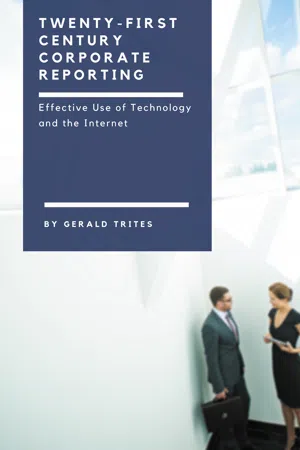
Twenty-First Century Corporate Reporting
Effective Use of Technology and the Internet
- 150 pages
- English
- ePUB (mobile friendly)
- Available on iOS & Android
About this book
How and why do corporations use the internet for reporting to their stakeholders? How and why has corporate reporting extended beyond financial reporting to include environmental, social, and governance (ESG) reporting and even integrated reporting. The major drivers of modern reporting have changed, to include data driven decision making, big data, and advanced analytics, as well as the use of electronic representations of data with tools such as XBRL.
Here we explore the various vehicles for using the internet, including social media and blogs as well as corporate websites and the websites of regulators. And we delve into the impact of portable devices, like smartphones and tablets.
Corporate reporting on the internet is changing fast because of changes in technology and stakeholder expectations. Companies are having a hard time keeping up. This book offers a roadmap to follow–a roadmap to start on now. Most importantly, the book lays out a strong case for integrated reporting and shows how reporting on the internet is ideally suited to the creation of integrated reports.
This book is of interest to executives in charge of the reporting function for their companies, students of accounting and management, and to serious investors and others with a strong interest in corporate reporting and the direction in which it is headed.
Frequently asked questions
- Essential is ideal for learners and professionals who enjoy exploring a wide range of subjects. Access the Essential Library with 800,000+ trusted titles and best-sellers across business, personal growth, and the humanities. Includes unlimited reading time and Standard Read Aloud voice.
- Complete: Perfect for advanced learners and researchers needing full, unrestricted access. Unlock 1.4M+ books across hundreds of subjects, including academic and specialized titles. The Complete Plan also includes advanced features like Premium Read Aloud and Research Assistant.
Please note we cannot support devices running on iOS 13 and Android 7 or earlier. Learn more about using the app.
Information
Table of contents
- Cover
- Half-Title Page
- Title Page
- Copyright
- Description
- Contents
- Preface
- Introduction
- Chapter 1 The Components of Corporate Reporting
- Chapter 2 Stakeholder Needs
- Chapter 3 Contemporary Corporate Websites
- Chapter 4 The Movement to Data
- Chapter 5 Static, Dynamic, and Interactive Data
- Chapter 6 Use of Graphics and Other Multimedia
- Chapter 7 Use of Social Media and Blogs
- Chapter 8 Impact of Device Types
- Chapter 9 Environmental, Social, and Governance (ESG) Reporting
- Chapter 10 Integrated Reporting
- Summary and Conclusions
- Notes
- Bibliography
- About the Author
- Index
- Backcover